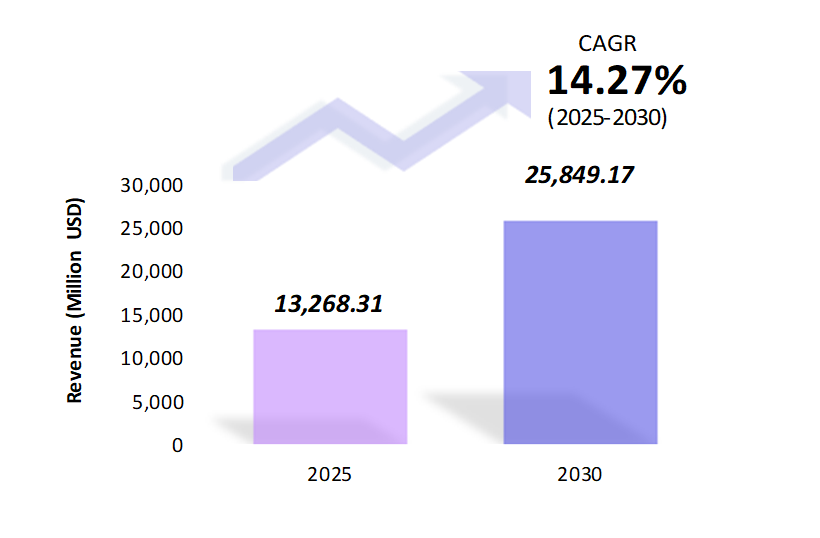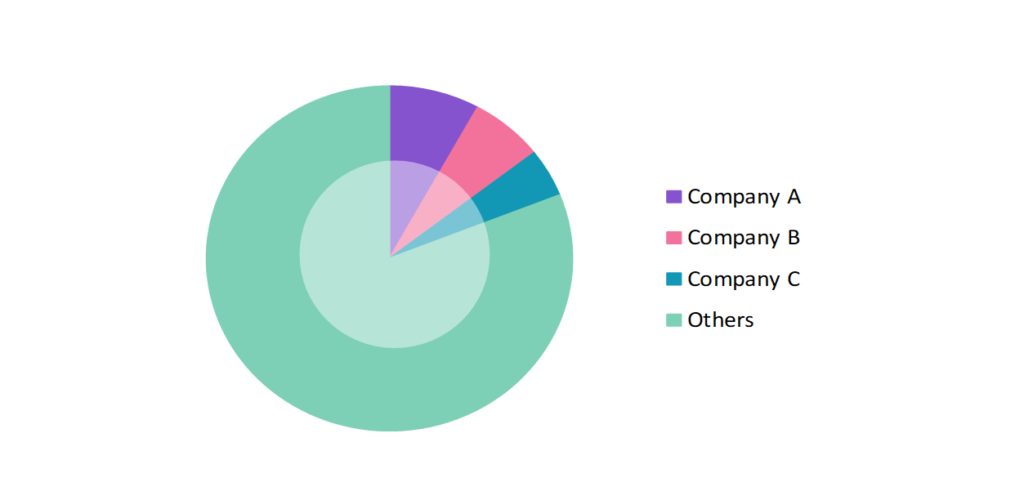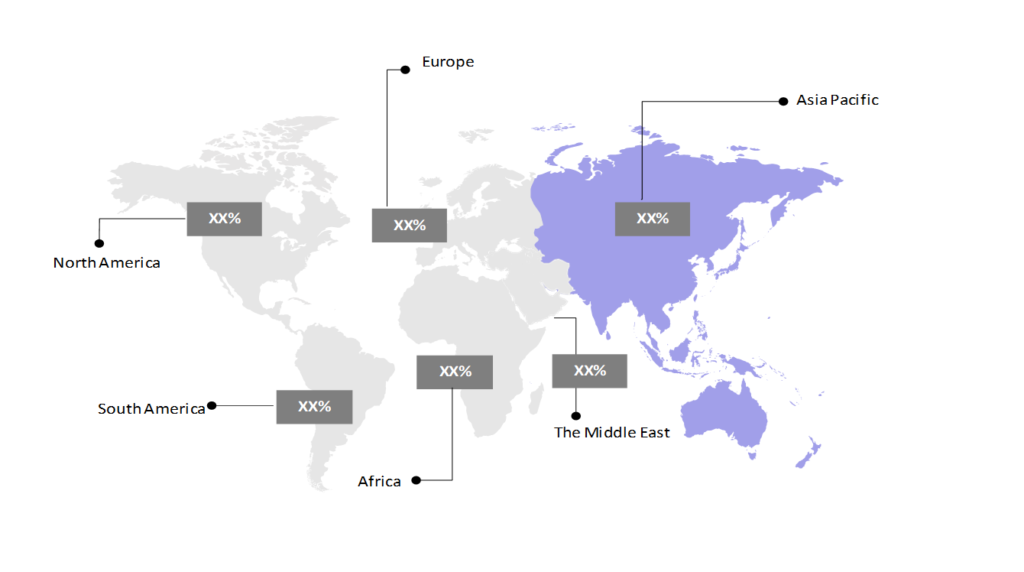Same Day Delivery Market Outlook: Size, Share, Trends & Growth Analysis (2024-2029)
The market report presents a thorough analysis segmented by Mode of Transportation (Airways, Roadways, Railways, Intermodal); by Application (Retail, E-Commerce, Healthcare, Manufacturing, Documents & Letters, Others); by Geography (North America, South America, Asia Pacific, Europe, The Middle East, Africa).
Outlook

- The same day delivery market is estimated to be at USD 13,268.31 Mn in 2025 and is anticipated to reach USD 25,849.17 Mn in 2030.
- The same day delivery market is registering a CAGR of 14.27% during the forecast period 2025-2030.
- The same-day delivery market is rapidly expanding as consumer demand for faster, more convenient shipping grows, driven by e-commerce and omnichannel retailing. Companies are investing heavily in logistics technology, micro-fulfillment centers, and subscription-based services to meet these expectations. However, operational costs, complexity in urban logistics, and environmental challenges remain barriers to growth. As competition intensifies, innovative solutions are essential for maintaining reliability and efficiency in this dynamic market.
Request a free sample.
Ecosystem

- The participants in the global same day delivery industry are always developing their strategies to preserve a competitive advantage.
- Companies are increasingly investing in technologies like AI for route optimization, autonomous vehicles, and drone deliveries to gain an advantage in delivery speed and cost-efficiency.
- Several important entities in the same day delivery market include Aramex PJSC; DHL Group; Dropoff, Inc.; FedEx Corp.; Jet Delivery, Inc.; and others.
Ask for customization.
Findings
| Attributes | Values |
|---|---|
| Historical Period | 2019-2023 |
| Base Year | 2024 |
| Forecast Period | 2025-2030 |
| Market Size (2025) | USD 13,268.31 Mn |
| Market Size (2030) | USD 25,849.17 Mn |
| Growth Rate | 14.27% CAGR from 2025 to 2030 |
| Key Segments | Mode of Transportation (Airways, Roadways, Railways, Intermodal); Application (Retail, E- Commerce, Healthcare, Manufacturing, Documents & Letters, Others); Geography (North America, South America, Asia Pacific, Europe, The Middle East, Africa) |
| Key Vendors | Aramex PJSC; DHL Group; Dropoff, Inc.; FedEx Corp.; Jet Delivery, Inc. |
| Key Countries | The US; Canada; Mexico; Brazil; Argentina; Colombia; China; India; Japan; Indonesia; The UK; Germany; Italy; France; Turkey; UAE; Saudi Arabia; Egypt; South Africa |
| Largest Market | Asia Pacific |
Get a free quote.
Trends
- Use of AI-driven Route Optimization: Companies use AI algorithms to analyze traffic patterns, weather, and delivery locations in real-time, optimizing routes for faster deliveries. For example, Amazon’s AI-based logistics system recalculates routes as orders come in, which reduces delivery times while cutting fuel costs and emissions. This technology also adapts to unforeseen delays, such as road closures or accidents.
- Establishment of Micro-Fulfillment Centers: Retailers are establishing small, automated warehouses in urban areas to store popular items closer to customers. Walmart has deployed micro-fulfillment centers in select cities, which allow drivers to pick up items from a nearby location and deliver them within hours. These centers also rely on robotics to quickly pick and pack items, enhancing delivery speed.
- Drone and Autonomous Vehicle Deliveries: Companies are testing drones and self-driving vehicles for rapid, contactless deliveries, particularly for urgent or remote orders. Zipline, a drone delivery service, delivers medical supplies in remote parts of Africa and is expanding to US regions to serve pharmaceuticals and small parcels, which reduces delivery times significantly.
Speak to analyst.
Catalysts
- Increasing E-commerce Demand: The surge in online shopping, accelerated by consumer convenience and pandemic-driven habits, drives demand for fast deliveries. E-commerce giants like Amazon and Alibaba are meeting consumer expectations by expanding same-day delivery services to more regions, which is pushing other retailers to follow suit and support market growth.
- Rising Consumer Expectations for Speed: Consumers now expect rapid delivery for both essential and non-essential goods, influenced by brands that offer faster shipping options. Walmart and Target have integrated same-day delivery as a competitive advantage to retain customers, boosting the market’s expansion as companies vie to match consumer expectations.
- Increase in Trading Activities Due to Globalization: The globalization of trade has led to a surge in cross-border transactions, which fuels demand for efficient and rapid delivery services worldwide. As companies expand their reach to international markets, same-day delivery options are increasingly valuable for both B2B and B2C segments. Businesses such as DHL and FedEx are offering express shipping solutions to meet tight delivery timelines for global orders.
Inquire before buying.
Restraints
- High Operational Costs: Same-day delivery requires significant investment in logistics, technology, and labor to ensure quick turnaround times, which can strain company budgets. Costs associated with fuel, driver compensation, and warehousing make same-day delivery services expensive to maintain, especially in low-density or remote areas, impacting profitability for many providers.
- Complexity of Urban Logistics: Traffic congestion, limited parking, and regulatory restrictions in urban areas add complexity to last-mile delivery operations. Companies like FedEx and UPS face challenges in navigating busy cities, which leads to delays and added costs. These obstacles make it harder to achieve consistent same-day delivery speeds, especially during peak times.
- Environmental and Sustainability Concerns: Rapid deliveries often lead to increased vehicle emissions due to more frequent trips and shorter delivery windows. As customers become more eco-conscious, companies face pressure to adopt sustainable practices. However, shifting to electric vehicles or eco-friendly alternatives involves upfront investment, posing a challenge to companies trying to balance efficiency with environmental impact.
Personalize this research.
Hotspot

Explore purchase options.
Table of Contents
| 1. Introduction 1.1. Research Methodology 1.2. Scope of the Study 2. Market Overview / Executive Summary 2.1. Global Same Day Delivery Market (2019 – 2023) 2.2. Global Same Day Delivery Market (2024 – 2030) 3. Market Segmentation 3.1. Global Same Day Delivery Market by Mode of Transportation 3.1.1. Airways 3.1.2. Roadways 3.1.3. Railways 3.1.4. Intermodal 3.2. Global Same Day Delivery Market by Application 3.2.1. Retail 3.2.2. E-Commerce 3.2.3. Healthcare 3.2.4. Manufacturing 3.2.5. Documents & Letters 3.2.6. Others 4. Regional Segmentation 4.1. North America 4.1.1. The US 4.1.2. Canada 4.1.3. Mexico 4.2. South America 4.2.1. Brazil 4.2.2. Argentina 4.2.3. Colombia 4.2.4. Rest of South America 4.3. Asia Pacific 4.3.1. China 4.3.2. India 4.3.3. Japan 4.3.4. Indonesia 4.3.5. Rest of Asia Pacific 4.4. Europe 4.4.1. The UK 4.4.2. Germany 4.4.3. Italy 4.4.4. France 4.4.5. Rest of Europe 4.5. The Middle East 4.5.1. Turkey 4.5.2. UAE 4.5.3. Saudi Arabia 4.5.4. Rest of the Middle East 4.6. Africa 4.6.1. Egypt 4.6.2. South Africa 4.6.3. Rest of Africa 5. Value Chain Analysis of the Global Same Day Delivery Market 6. Porter Five Forces Analysis 6.1. Threats of New Entrants 6.2. Threats of Substitutes 6.3. Bargaining Power of Buyers 6.4. Bargaining Power of Suppliers 6.5. Competition in the Industry 7. Trends, Drivers and Challenges Analysis 7.1. Market Trends 7.1.1. Market Trend 1 7.1.2. Market Trend 2 7.1.3. Market Trend 3 7.2. Market Drivers 7.2.1. Market Driver 1 7.2.2. Market Driver 2 7.2.3. Market Driver 3 7.3. Market Challenges 7.3.1. Market Challenge 1 7.3.2. Market Challenge 2 7.3.3. Market Challenge 3 8. Opportunities Analysis 8.1. Market Opportunity 1 8.2. Market Opportunity 2 8.3. Market Opportunity 3 9. Competitive Landscape 9.1. Aramex PJSC 9.2. DHL Group 9.3. Dropoff, Inc. 9.4. FedEx Corp. 9.5. Jet Delivery, Inc. 9.6. Company 6 9.7. Company 7 9.8. Company 8 9.9. Company 9 9.10. Company 10 |
Know the research methodology.
Same Day Delivery Market – FAQs
1. What is the current size of the same day delivery market?
Ans. In 2025, the same day delivery market size is USD 13,268.31 Mn.
2. Who are the major vendors in the same day delivery market?
Ans. The major vendors in the same day delivery market are Aramex PJSC; DHL Group; Dropoff, Inc.; FedEx Corp.; Jet Delivery, Inc…
3. Which segments are covered under the same day delivery market segments analysis?
Ans. The same day delivery market report offers in-depth insights into Mode of Transportation, Application, and Geography.
